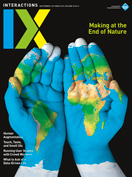Authors:
Elizabeth Churchill, Melissa Cefkin, Bob Irwin, Robbie Floyd, Lucy Suchman, Jeanette Blomberg, Susan Stucky
It is with great sadness that we report on Brigitte (Gitti) Jordan's death; Gitti died on May 24, 2016, at her home in La Honda, California, surrounded by loved ones. She was 78.
While the influence of anthropology and the practice of ethnography may seem very familiar to us in the HCI and technology design world today, it was not always so. During the 1980s and 1990s, a number of trailblazing researchers laid the groundwork for what we now take for granted when it comes to methods for understanding human activities with and around technologies. Gitti was one of those trailblazers. Her worldview was broad, but she always put people and their interests at the center, whether she was studying childbirth, the use of productivity tools, or autonomous vehicles. Her field sites included village huts, corporate research labs, and virtual worlds.
One of the pioneers of business and corporate ethnography, and what we now call design ethnography, Gitti always emphasized grounding design, and especially technology design, by understanding people's everyday landscapes, their needs, values, behaviors, and settings. Although SIGCHI and Interactions were not among Gitti's intellectual and publishing homes, she certainly had an influence on a number of people and projects that are part of the SIGCHI canon. Gitti coined the term "lifescapes of the future" and consistently used research on what is happening now to speculate about the changes that are likely to be wrought by the introduction of new technologies.
Gitti's curiosity about technologies in use by consumers, but also by technologists, went back a long way, and throughout her career she sustained an engaged yet highly critical relationship with computer modelers, cognitive scientists, and artificial intelligence researchers. Her master's thesis in 1971 explored how computer simulations might be better exploited by anthropologists. The thesis, Diffusion, Models and Computer Analysis: A Simulation of the Diffusion of Innovations, earned her an M.A. in 1971 from Sacramento State College.

Gitti's Ph.D. was based at the University of California, Irvine, where she engaged deeply with developments in ethnomethodology and conversational analysis, emerging thinking in cognition (now known as situated and distributed cognition), learning theory, and more. She also furthered her interest in computer science, taking a course with the young professor John Seely Brown, who went on to lead Xerox PARC (Palo Alto Research Center) and who, when there, invited Gitti to join PARC. At PARC, Gitti worked with Lucy Suchman, Jeanette Blomberg, Julian Orr, and other pioneers to advance the contributions of anthropological and ethnographic study of complex technology. At the same time, she became a senior researcher at the Institute for Research on Learning (IRL), where she played a central role in establishing IRL's depth of focus and understanding of processes of social learning wherever it is found. Gitti led numerous teams through rich and challenging projects in corporate workplace settings to examine and help support meaningful knowledge economies. Gitti had a keen interest in methodology, leading regular interaction analysis labs at both PARC and IRL.
In the last years of her life, she consulted to the Nissan Research Center in Silicon Valley, a lab led by artificial intelligence scientists and roboticists aiming to develop autonomous vehicles. In this environment, Gitti insisted on the need to dedicate equal, if not more, attention to the human implications of this emerging technology.
Gitti had boundless curiosity, great warmth, and an encouraging style. Her standards regarding ideas and empirical realities and their interactions were high and exacting. Again and again people point to her as the reason they are doing what they are doing—and more important, for finding and rekindling their sense of excitement and importance in the work that they do. She was respected, admired, and loved by her colleagues, family, and friends, and her multiple legacies will live on as others continue to carry forward her work in the major fields she helped to found.
Copyright held by authors
The Digital Library is published by the Association for Computing Machinery. Copyright © 2016 ACM, Inc.







Post Comment
No Comments Found